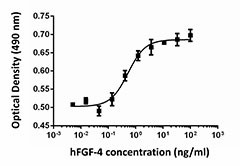- Regulatory Status
- RUO
- Other Names
- Fibroslast Growth Factor 4 (FGF-4), Heparin-Binding Growth Factor 4 (HBGF-4), HST-1, K-FGF, KS3, Kaposi Sacrcoma Oncogene, Heparin Secretory Transforming Protein 1 (HSTF-1)

-

NIH3T3 proliferation induced by human FGF-4.
| Cat # | Size | Price | Quantity Check Availability | ||
|---|---|---|---|---|---|
| 592204 | 25 µg | $218.00 | |||
| 592206 | 100 µg | $692.00 | |||
FGF-4 was first identified as HST-1 gene by a NIH3T3 transforming assay. It belongs to the FGF family that includes 22 members FGF1-FGF23. FGF15 has not been identified in humans. FGF-4 exhibits strong effects on many different cell types and tissues, and plays important roles in both embryogenesis and adult tissue stem cell development in a variety of organisms. FGF-4 can stimulate limb mesenchyme proliferation and can provide all the signals required for normal outgrowth and patterning of the limb. FGF-4 mRNA has been detected in the apical ectodermal ridge of the limb bud in Days 11 and 12 embryos. FGF-4 is also involved in early heart development by supporting the proliferation and differentiation of precardiac myoblasts. In adults, FGF-4 is expressed in the testis and its overexpression results in enhanced spermatogenesis. FGF-4 is also a potent inducer of platelet production from megakaryocytes. FGF-4 expression has been detected in the brain at both neonatal and adult stages. FGF-4 can induce neural stem cell proliferation and neuronal differentiation. The diverse functions of FGF-4 are mediated by FGF receptors (FGFR) that contain an extracellular ligand-binding domain with three immunoglobulin-like domains. Like other FGFs, FGF-4 also binds to anionic glycosaminoglycans heparin and heparin sulfate with high affinity. Heparin sulfate availability has been shown to regulate the binding between FGF-4 and its receptors. The role of FGF-4 in cancer has also been extensively investigated. FGF-4 is an angiogenic protein, and amplification of FGF-4 gene has been found in many human tumors. It has been shown that FGF-4 is a potential target for the treatment of human testicular tumors.
Product Details
- Source
- Human FGF4, amino acids Ser54-Leu206 (Accession# P08620) was expressed in E. coli.
- Molecular Mass
- The 153 amino acid recombinant protein has a predicted molecular mass of approximately 19.7 kD. The non-reduced and DTT-reduced protein migrates at approximately 19.7 kD by SDS-PAGE. The predicted N-terminal amino acid is Serine.
- Purity
- >95%, as determined by Coomassie stained SDS-PAGE.
- Formulation
- 0.22 µm filtered protein solution is in PBS.
- Endotoxin Level
- Less than 0.01 ng per µg cytokine as determined by the LAL method.
- Concentration
- 10 and 25 µg sizes are bottled at 200 µg/mL. 100 µg size and larger sizes are lot-specific and bottled at the concentration indicated on the vial. To obtain lot-specific concentration and expiration, please enter the lot number in our Certificate of Analysis online tool.
- Storage & Handling
- Unopened vial can be stored between 2°C and 8°C for up to 2 weeks, at -20°C for up to six months, or at -70°C or colder until the expiration date. For maximum results, quick spin vial prior to opening. The protein can be aliquoted and stored at -20°C or colder. Stock solutions can also be prepared at 50 - 100 µg/mL in appropriate sterile buffer, carrier protein such as 0.2 - 1% BSA or HSA can be added when preparing the stock solution. Aliquots can be stored between 2°C and 8°C for up to one week and stored at -20°C or colder for up to 3 months. Avoid repeated freeze/thaw cycles.
- Activity
- The ED50 is 0.2-1 ng/ml, corresponding to a specific activity 1-5 x 106 units/mg, as determined by a dose-dependent stimulation of NIH3T3 cell proliferation.
- Application
-
Bioassay
- Application Notes
-
BioLegend carrier-free recombinant proteins provided in liquid format are shipped on blue-ice. Our comparison testing data indicates that when handled and stored as recommended, the liquid format has equal or better stability and shelf-life compared to commercially available lyophilized proteins after reconstitution. Our liquid proteins are verified in-house to maintain activity after shipping on blue ice and are backed by our 100% satisfaction guarantee. If you have any concerns, contact us at tech@biolegend.com.
- Product Citations
-
Antigen Details
- Structure
- Growth factor.
- Distribution
-
Expression of FGF-4 is highly restricted to undifferentiated stem cells.
- Function
- FGF-4 is a mitogenic, angiogenic, and survival factor. It is involved in cell proliferation and differentiation in embryonic development processes. N-glycosylation may negatively regulate FGF-4 activity.
- Interaction
- Precardiac myoblasts, megacariocytes, neural stem cells.
- Ligand/Receptor
- FGFR-I, IIIc; FGFR-2, IIIc; FGFR-3, IIIc, FGFR-4.
- Cell Type
- Embryonic Stem Cells, Hematopoietic stem and progenitors, Mesenchymal Stem Cells, Neural Stem Cells
- Biology Area
- Apoptosis/Tumor Suppressors/Cell Death, Cell Biology, Cell Cycle/DNA Replication, Neuroscience, Stem Cells, Synaptic Biology, Transcription Factors
- Molecular Family
- Cytokines/Chemokines, Growth Factors
- Antigen References
-
1. Konishi H, et al. 1996. Oncogene. 13:9.
2. Sun X, et al. 2000. Nat. Genet. 25:83.
3. Yamamoto H, et al. 2002. Oncogene 21:899.
4. Kosaka N, et al. 2006. FASEB J. 20:1484.
5. Kosaka N, et al. 2009. Dev. Dyn. 238:265.
6. Arao T, et al. 2013. Hepatology 57:1407.
7. Itoh N and Ohta H. 2013. Front. Physiol. 4:247. - Gene ID
- 2249 View all products for this Gene ID
- UniProt
- View information about FGF-4 on UniProt.org
